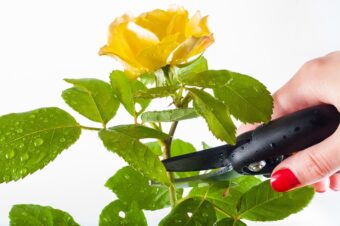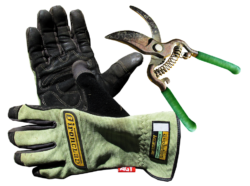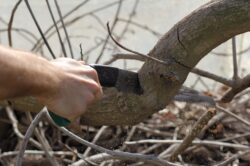In this article, we will discover the best way to pruning your plants, a task which every gardener must learn, even container gardeners. The problem is a lot of inexperienced gardeners do it wrong. To understand pruning, you need to know why you need to prune in the first place.

This is done for 3 main reasons:
- To remove unhealthy and dead material to make it look better.
- To stop a monster from being reared in your garden, so it is kept to a certain size and shape.
- and to increase the production of flowers and therefore fruiting.
This can be remembered as dead, shape and production.
The truth is that pruning is not easy as it does take time to become a good pruner. It is not a natural-born gift that anybody has and you will make errors, maybe kill a plant or two.
This is why it is important to learn the basics.
First, you need to remove the dead branches, dying branches and any diseased material. Take out any branches that are crossing as they can rub off bark and can lead to an entry point to which pests and diseases can infect the plant.
Next, you will need to prune to keep the plant in shape and this is the most common reason why pruning is carried out.
DO NOT RUSH IT
This job must not be rushed, take your time and prune whilst considering the plant look overall. It is too easy to get carried away and chop off far more than necessary, with the result is that the new growth will be too weak and spindly. If you think that you are losing control and hacking the plant instead of improving its look, then take a breather, have a cup of tea and come back to it later, with a clearer picture.
Do not prune in early spring after new shoots appear because this will weaken the plant in the long run and how it produces new growth.
Do not prune in early autumn as well, as this will encourage a new flush of growth, which will be soft and easily killed off by frosts.

There are so many ways to prune and no way is better than each other. You cannot summarise all the techniques into a single article, as a lot will still need to be learnt. For example, there is no point in learning how to prune privets if you do not have one and then applying what you learnt to prune a cherry tree. It is not that simple.
Learn the techniques that are relevant to you and your garden and the plants within it. Find out what you have in your garden and do research, I cannot guide you individually, so you get it right the first time. The guide is for persons who do know what they have and are willing to get grips with basic botany and pruning.
PRUNING TREES
All trees and shrubs produce a topmost bud that is known as the apical bud that is dominant. This apical bud produces hormones that restrict the growth of the lower buds further down, which stops the plant from being overcrowded and competition within the plant. The very topmost stem has a different appearance that shows that apical dominance and the way that the stem grows.

If you get rid of this apical bus and stem, you will divert the hormones to the low set of buds, allow them to turn into dominant stems. The buds below these new apical buds will therefore restrict buds below them. This is a long-winded way of saying if your prune or pinch out the leader stem, you will allow the buds to develop below and for the plant to grow bushier.
If you cut the apical bud of a tree, you will stop the trees from growing directly upward. Conifers and upright trees with an obvious leader will be ruined and you will make the tree look very odd.
Do not cut out big branches high up, as this is too much for basic gardeners. It is best to call a tree surgeons instead.
ONLY PRUNE SMALL BRANCHES
Only prune small branches that you can reach and where you do not need to use a chainsaw.
Never try to cut it thick, heavy branches in one go. Even small branches are heavy and hard to control with only one hand. It is best to cut these branches into sections to lessen the weight you have to hold.
Cut underneath first with a partial cut, as this will keep the bark from tearing down from the trunk of the branch accidentally breaks.
For any deciduous tree, it is better to prune when the tree is without leaves, as the branches will be lighter and no sap will be seeping from cuts. For most basic gardeners a tree will be too big to deal with, so a specialist tree surgeon will have to do it. Only tackle small trees.
PRUNING SHRUBS
With shrubs removing the apical bud will not lead to a bald tree, but will often lead to a bushy growth that is desired. Cuts are still important nevertheless.

For example, if you cut a branch inside incorrectly new growth will lead to side-shoots forming and the plant will become congested once again. Instead of this, it is better to remove all the stems that are growing inwards right at the base of the shrub in early spring.
Dogwoods, willows, buddleias and hazels should be pruned this way. Other shrubs should only be cut to shape and any dead or crossing branches should be cut off, but each shrub has its own requirements, so do consult books.
Any prunings that you make can be shredded and turned into material suitable for composting. Dogwoods, hazels and willows produce flexible branches that can be used to make low fences or supports for climbing plants such as sweet peas. They have many uses in the garden. When you are cutting it should be on a slant, so that rainwater will runoff. Also, make sure that the cut is not too far away from a leaf bud.
PRUNING PERENNIALS
Perennials are plants that go dormant in winter late autumn and winter, sending their nutrients and energy into the roots and ground, before emerging again in spring. By late winter, the plants will look the worse and you can cut them back.
You can do it earlier, but if you save some until spring where the dead plant stems will help a lot of insects. If new shoots appear, take care not to cut off any of these new growths. Cut back near to the ground where all green grown has gone and any brown stems and flowers that remain.
Many perennials can give a second flush of flowers if they are pruned halfway through the growing season, A good way to tell is if the perennial has tall leggy, lanky growth and lots of new growth at the bottom, as this will promote new shoots to flowers later in the season.
PRUNING BAMBOOS AND GRASSES
In late summer or early spring, bamboos can be brought under control. You can let more air in and more light by removing all the old canes at the base, leaving only healthy, young leaves. You can remove as many canes as you like as it is hard to kill bamboo, even if you chop all the canes to the ground.
Most ornamental grasses need to be trimmed annually to keep them tidy and to make them look attractive. If by late summer, all look dead then trim it back to the ground in winter. If it is still green in autumn, trim it back to the ground in early spring. Even green grasses and sedge need to be lightly raked with a spring rake to remove old clumps and brown leaves. Do not ever cut evergreen grasses to the ground as this will kill them.
CONCLUSIONS
In this article, we have discussed a rough guide on how to prune various plants. Although all plants will have different needs in terms of pruning and you will need to consult them individually if you want to prune your plants correctly. What is offered in this article is the basic of pruning, which is not totally comprehensive but a guide to get you started.
Trees, shrubs and perennials, bamboos and grasses are touched upon. Get to know the plants in your garden and when to prune them, it will save a lot of heartaches and you will have a better-looking garden.
If you have any questions or comments that you wish to make on this topic, then please leave a comment below in the box.
Happy pruning.
